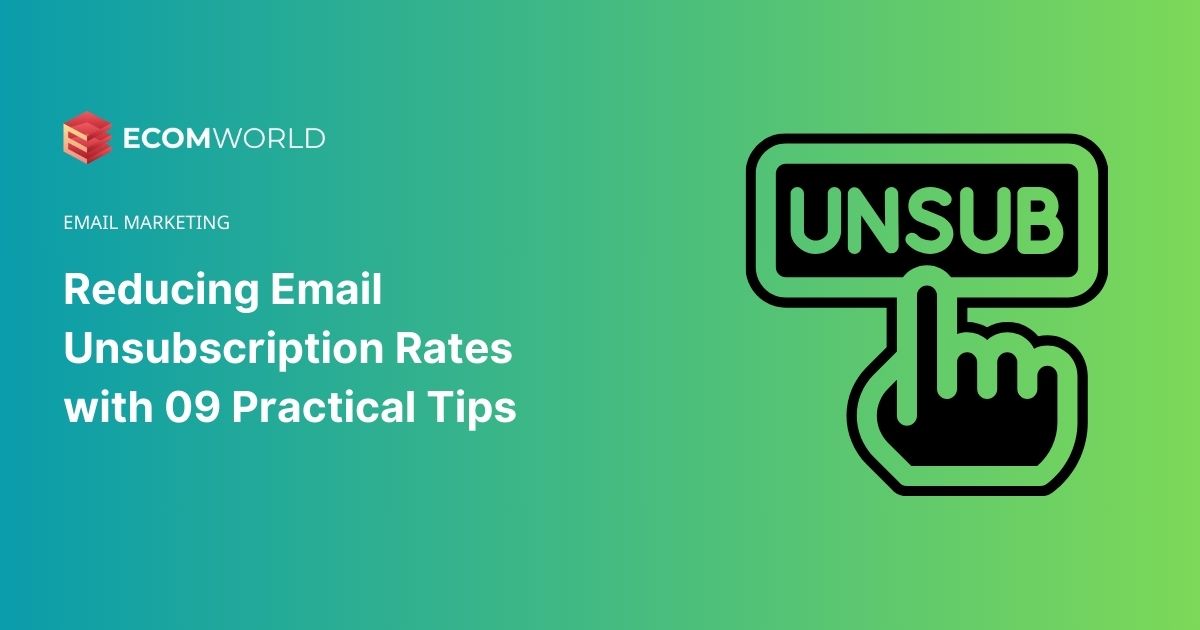In the fast-paced digital landscape of today, our email inboxes are constantly inundated with messages from various sources, ranging from newsletters and promotional offers to important updates from businesses and organizations. While email marketing remains a powerful tool for connecting with audiences, ensuring that your emails are not only opened but also well-received is a challenge in itself. One crucial metric that measures the effectiveness of your email campaigns is the email unsubscribe rate. In this blog, we’ll dive into the world of email unsubscribe rates, exploring what they mean, why they matter, and most importantly, providing you with a comprehensive set of tips to decrease them. Whether you’re a seasoned email marketer or just starting out, understanding how to retain your email subscribers is essential for maintaining a healthy and engaged audience. So, let’s embark on a journey to uncover the secrets of reducing email unsubscribe rates and keeping your recipients eagerly awaiting your next message.
Table of Contents
What is the Email Unsubscribe Rate?
The email unsubscribe rate represents the proportion of individuals who have chosen to leave an email list following an email campaign. An increase in this metric serves as an indicator of the effectiveness of your email campaign.
The unsubscribe rate possesses a dual nature. While it may raise apprehensions among marketers, it also comes with a potentially positive aspect.
The silver lining to email unsubscribe rate
Unsubscribe rates can actually be a hidden blessing – you heard that right! As an email marketer, an uptick in your unsubscribe rate can be seen as a positive sign that your email list is undergoing a self-cleansing process.
This process can ultimately leave you with a more robust and healthy list. By maintaining this level of email list hygiene, you gain better control over your email unsubscribe rate in the long run. However, it’s important to note that expecting a 0% unsubscribe rate is an unrealistic goal.
Certainly, it can be disheartening to see subscribers disengage from the valuable content you’ve put so much effort into creating. Nevertheless, the payoff is significant: your emails will now be read exclusively by those subscribers who are genuinely interested in your offerings. Therefore, some degree of email list churn should be anticipated when launching your email campaign.
How to calculate the unsubscribe rate?
Determining the unsubscribe rate is a fairly simple process. You merely need to divide the total number of unsubscribes by the overall number of subscribers. The result is expressed as a percentage.
For instance, if you send out 5000 emails and 5 subscribers opt to unsubscribe, the calculated unsubscribe rate would be 0.1%.
In essence, the formula for computing the email unsubscribe rate is as follows:
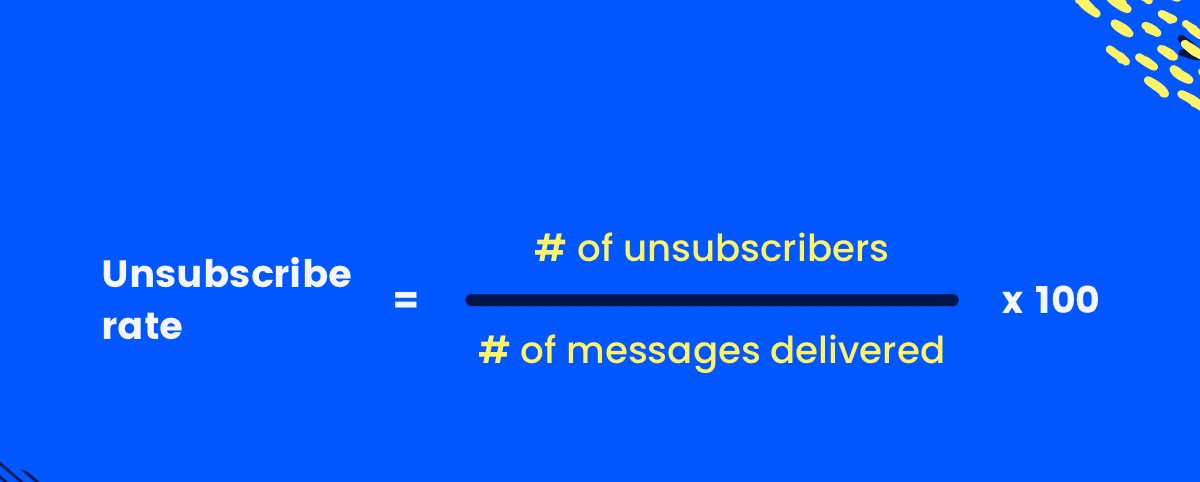
However, focusing solely on gauging the email unsubscribe rate won’t provide you with a comprehensive view of your email campaign’s performance. It’s essential to assess various other email marketing metrics, including email open rate, email bounce rate, and email click-through rates, in order to gauge the overall effectiveness of your email marketing endeavors.
Email unsubscribe rate across industries
Unsubscribe rates exhibit variation across different industries. Therefore, the most effective method for assessing the performance of your campaigns is to benchmark them against the average unsubscribe rates within your specific industry.
Here are unsubscribe rates drawn from Mailchimp for various industries:
- Agriculture and Food services: 0.25%
- Architecture and Construction: 0.32%
- Beauty and Personal Care: 0.30%
- Business and Finance: 0.20%
- Computer and Electronics: 0.27%
- Creative Services/Agency: 0.35%
- eCommerce: 0.27%
- Entertainment and Events: 0.26%
- Government: 0.13%
- Health and Fitness: 0.40%
- Marketing and Advertising: 0.27%
- Media and Publishing: 0.12%
- Real Estate: 0.27%
- Software and Web Applications: 0.37%
- Travel and Transportation: 0.24%
Based on this data, the average unsubscribe rate across these industries is approximately 0.26%.
What is a good email unsubscribe rate?
According to SmartInsights, a typical unsubscribe rate stands at 0.5%, and an unsubscribe rate of 0.2% or lower is considered exceptional. Therefore, if your unsubscribe rate falls within the range of 0.17% to 0.2%, it indicates that your email list primarily consists of genuinely interested subscribers.
In the initial stages, newly created email lists often exhibit higher unsubscribe rates, which shouldn’t be a cause for alarm. This phenomenon arises because individuals require time to determine whether they wish to establish a rapport with your brand. Additionally, some subscribers may need time to acclimate to your communication style, resulting in a temporary surge in unsubscribes.
However, as your email list matures and stabilizes, you can expect to witness a decline in the unsubscribe rate, as only those individuals who genuinely wish to engage with your brand will remain subscribed.
4 Reasons for High Email Unsubscribe Rate
If your unsubscribe rate keeps above 0.5% or near 1%, then the following factors might be the reasons for such a high unsubscribe rate:

Email fatigue
Email fatigue refers to the point when a recipient begins to feel overwhelmed by the volume of emails they receive, leading to decreased engagement or even complete disengagement. Persisting in sending excessive emails may prompt them to unsubscribe from your email list or designate your emails as spam, ultimately impacting your email deliverability.
The primary factor contributing to email exhaustion is the frequency of email dispatches. According to Hubspot, a substantial 51% of subscribers opt out due to excessive email frequency.
To mitigate email exhaustion, it is advisable to assess the typical email frequency within your industry and establish an email schedule that optimizes the outcomes of your email marketing campaigns.
Irrelevant content
Another significant contributor to escalating unsubscribe rates is the delivery of content that lacks relevance. In today’s fast-paced environment, individuals are increasingly selective about the emails they invest their time in. Consequently, the sole effective measure to forestall surging unsubscribe rates is by dispatching personalized emails.
Leveraging the data gleaned from subscribers’ interactions with your emails, website, sales funnels, or prior purchases is essential. Employ automated email campaigns tailored to each subscriber’s progress through the sales funnel, enhancing their overall experience.
No understanding of buyer’s cycles
Comprehending the purchasing cycles holds immense significance, as it can lead to increased sales or renewals while concurrently diminishing unsubscribe rates. A typical buyer’s journey encompasses the following stages:
- Awareness
- Discovery
- Consideration
- Conversion
In the context of eCommerce products, the transition to the fourth stage can transpire swiftly. Therefore, it’s imperative to have well-prepared emails ready to dispatch the moment a purchase is made, such as confirmation and gratitude emails.
Furthermore, it’s essential to ensure that your email communication adheres to a coherent sequence. For instance, if a buyer remains in the awareness phase and receives emails inundated with offers or discounts, they may perceive your approach as overly aggressive, potentially deterring them from your product or service.
Hence, implementing an email drip campaign emerges as the most efficient and coherent approach to regulate your email cadence. Drip emails afford you the ability to guide buyers on how and when they engage with your emails, fostering a more logical and personalized interaction.
Limited or no segmentation
An unsegmented email list, or one with minimal segmentation, comprises a wide array of subscribers, including those who lack interest in receiving your emails. Over time, these disinterested subscribers are likely to opt out, leading to a surge in the unsubscribe rate.
To maintain email list cleanliness and enhance targeting precision, it’s imperative to eliminate inactive subscribers and apply segmentation criteria like interests, demographics, gender, location, and more. This strategic approach guarantees that your emails reach only those individuals genuinely eager to receive them.
9 Tips for reducing email unsubscribe rate
Up until now, you’ve gained insights into the concept of an email unsubscribe rate and the prevalent causes of its elevation. It’s now the opportune moment to acquaint yourself with actionable tips aimed at lowering it to a more acceptable threshold.
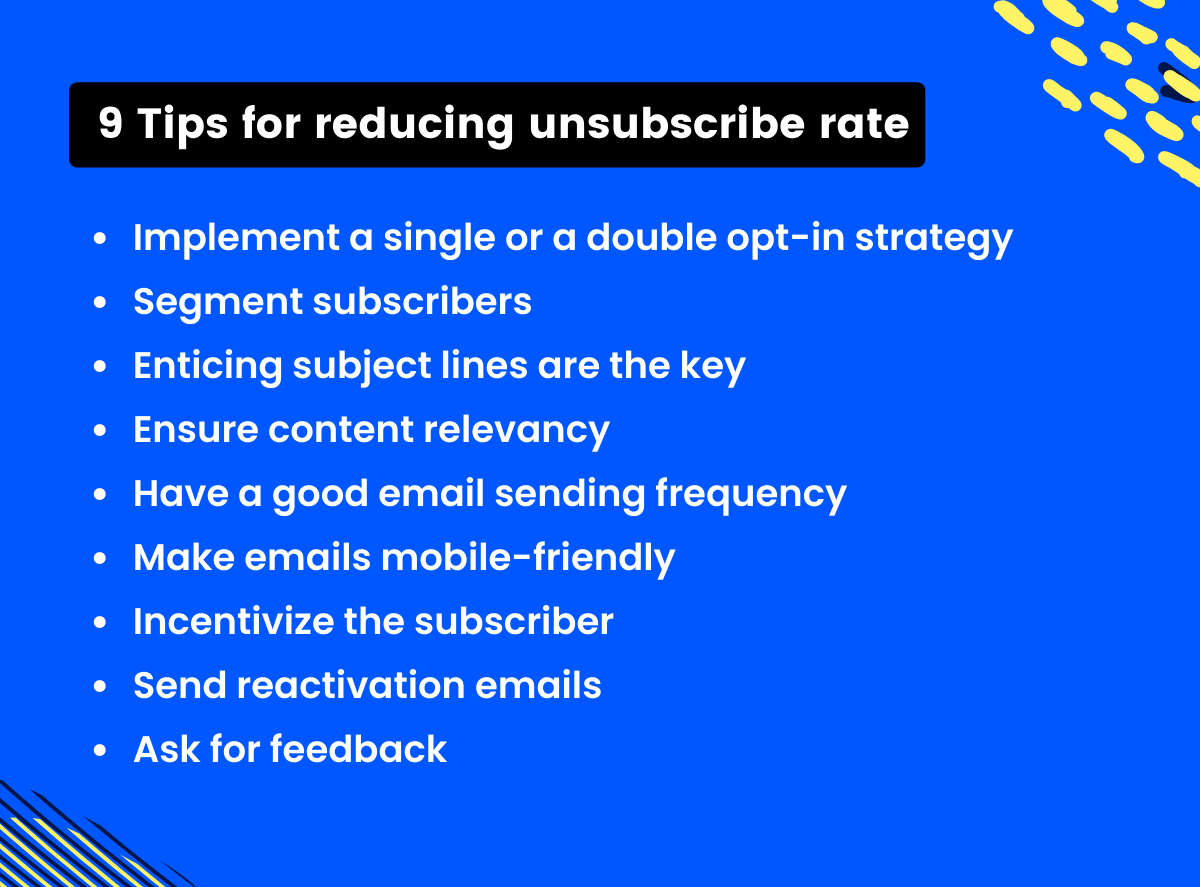
Implement a single or a double opt-in strategy
Requesting permission to send emails stands as a potent approach for mitigating unsubscribe rates since it ensures that only genuinely interested individuals choose to join your mailing list.
Employing either single or double opt-in forms can effectively put this strategy into practice. Furthermore, it’s worth noting that the CAN-SPAM Act mandates email marketers to obtain user consent through opt-in mechanisms prior to sending them emails.
Segment subscribers
Just as the fingers on a hand differ in size, no two subscribers are identical. They harbor varying interests and preferences, underscoring the vital importance of segmenting your subscriber base. This segmentation should be based on factors like interests, gender, demographics, and any other pertinent criteria, resulting in a more refined and precisely targeted email list.
It’s advisable to establish at least two criteria for segment definition. These criteria can encompass a wide spectrum, ranging from past purchase behavior and frequency to demographics, abandoned cart history, or any other relevant factors. Crafting such a focused email list empowers you to personalize your emails more effectively, thereby enhancing subscriber engagement.
Enticing subject lines are the key
Now, with everything meticulously prepared, you’ve secured subscribers’ consent to send them emails, crafted compelling content, but you find yourself grappling with the challenge of creating captivating subject lines. “What words will entice them to open my email?” you ponder. Yet, despite prolonged contemplation, inspiration remains elusive—frustrating, isn’t it?
Subject lines hold the pivotal role of being the very first impression a recipient encounters. Astonishingly, a staggering 69% of recipients make the snap decision to mark emails as spam based solely on the subject line. Thus, overlooking the significance of the subject line would be a grave oversight.
The most effective subject lines possess an inherently human touch, appearing as though they’ve been personally composed. Inject a personalized element by incorporating the recipient’s name, such as “John, We Need To Talk.” Additionally, it’s essential to present your subject lines in title case for maximum impact.
Furthermore, as per insights from Invespcro, subject lines spanning 6 to 10 words enjoy the highest open rates. While emojis can add a touch of visual appeal, exercise restraint to avoid overuse, which can detract from the professionalism of your subject line.
Ensure content relevancy
The subsequent crucial phase involves the delivery of pertinent content. An intricately devised content strategy plays a pivotal role in ushering a buyer through their purchasing journey. Here are some steps to consider when formulating your content strategy:

Define a goal
Similar to every endeavor, your emails should possess a clear objective. Before composing an email, it’s essential to ponder, “What do I aim to accomplish with this email?” Whether your intention is to steer or enlighten the recipient or to boost sales, the email’s purpose should be impeccably mirrored in its content.
An exemplary illustration of goal definition is evident in this email from Blurb, a self-publishing firm. The email explicitly states its aim: to enhance sales by extending a 35% discount on photo books.
Choose who to send
The subsequent task entails identifying the recipients for your emails. The optimal approach involves curating a meticulously segmented email list comprising individuals genuinely keen to receive your communications. Through this thoughtful segmentation, you can also minimize the likelihood of subscribers opting out.
Personalize the message
Personalized emails have a reduced likelihood of being flagged as spam by the recipient. Initiate the personalization process from the very outset with the subject line, incorporating the recipient’s name into it. Moreover, capitalize on the customer data provided during their initial subscription to your email list when offering promotions, even employing this data for sending cart abandonment emails.
Additionally, ensure that your email content is impeccably formatted. An astonishing 70% of mobile readers discard emails that are not correctly formatted within a mere three seconds of opening them.
Observe how adeptly Jack Wills, a fashion and apparel retailer, has crafted a cart abandonment email. This email not only addresses the recipient by name but also serves as a reminder regarding their abandoned cart.
Send a variety of content
Avoid monotony by refraining from sending repetitive content to your audience. Establish and maintain a content calendar as a tool for monitoring your content distribution. This calendar serves as a tracking mechanism, enabling you to gauge the type of content previously dispatched and plan what’s next in line.
Commence your email strategy with welcome messages, which are then succeeded by informative content such as ebooks. This initial approach serves to familiarize the recipient with your brand and positions you as a credible authority in your industry. Subsequently, transition into promotional emails, designed to captivate the reader’s interest and prompt them to take action.
By consistently providing engaging content, you can retain your audience’s interest, fostering a long-lasting subscriber relationship.
Have a good email-sending frequency
When your subscribers don’t receive frequent updates from you, there’s a heightened probability that they may choose to opt out of your email lists. Consequently, it’s imperative not to hesitate in maintaining a consistent email cadence. Ensure your subscribers receive communication from you at least twice a month.
As you cultivate a strong rapport with your audience, you have the leeway to gradually escalate the frequency of your emails. If you have multiple offers or compelling content to share, you can consider increasing your email frequency to two or three times a week.
Make emails mobile-friendly
Since over half of email campaigns are accessed on mobile devices, it’s crucial to ensure your emails are optimized for mobile viewing. Neglecting mobile optimization can lead to recipient dissatisfaction and heighten the risk of unsubscribing. Here are some pointers for enhancing the mobile-friendliness of your emails:

Enlarge the fonts
Avoid employing minuscule fonts, as they can discourage readers from interacting with your emails. Maintain a header font size ranging from 22 to 28 pixels. For the body text, opt for a font size ranging between 14 and 18 pixels, accompanied by a line spacing of 1.4 or 1.5.
By adhering to a font size in the 14-18 pixel range, you can accommodate disparities in font rendering across different email client platforms.
Keep content short & crisp
Stick to the essentials in your communication; avoid unnecessary embellishments or filler language. Additionally, ensure the accuracy of your claims—refrain from overstating your brand’s attributes.
Incorporate images and infographics to provide recipients with a clearer understanding of your brand.
Make the CTAs touch-friendly
Facilitate recipient action following email consumption by optimizing the touch-friendliness of your call-to-action (CTA) buttons. Employ contrasting colors to enhance the CTA button’s visibility. Additionally, ensure that the CTA is interactive and strategically positioned for easy detection, whether in the email header or footer.
Optimize the images
Lagging image load times can cause recipient frustration, potentially leading to email deletion or unsubscribing from your mailing list. Additionally, such delays in image loading can trigger spam filters. As a precaution, it’s advisable to limit the image width to a maximum of 600 pixels.
Consider converting your images to the PNG file format, as it offers superior quality. However, keep in mind that PNG files may be larger in size. Therefore, employ a dependable compression tool to minimize file size while ensuring minimal quality loss.
Incentivize the subscriber
Providing rewards to your subscribers can help maintain their engagement with your emails. It’s a means of demonstrating your subscribers’ importance and the value you place on them. Furthermore, consistent incentive offerings can foster brand loyalty among your subscribers.
A highly effective approach to presenting incentives is by incorporating gamification elements. This can be achieved through mechanisms like pinwheels or other gamification elements.
Pizza Hut stands out as an excellent example of gamifying their emails to offer incentives to their customers. They ingeniously employed a slot machine concept to grant 10-15% discounts on orders.
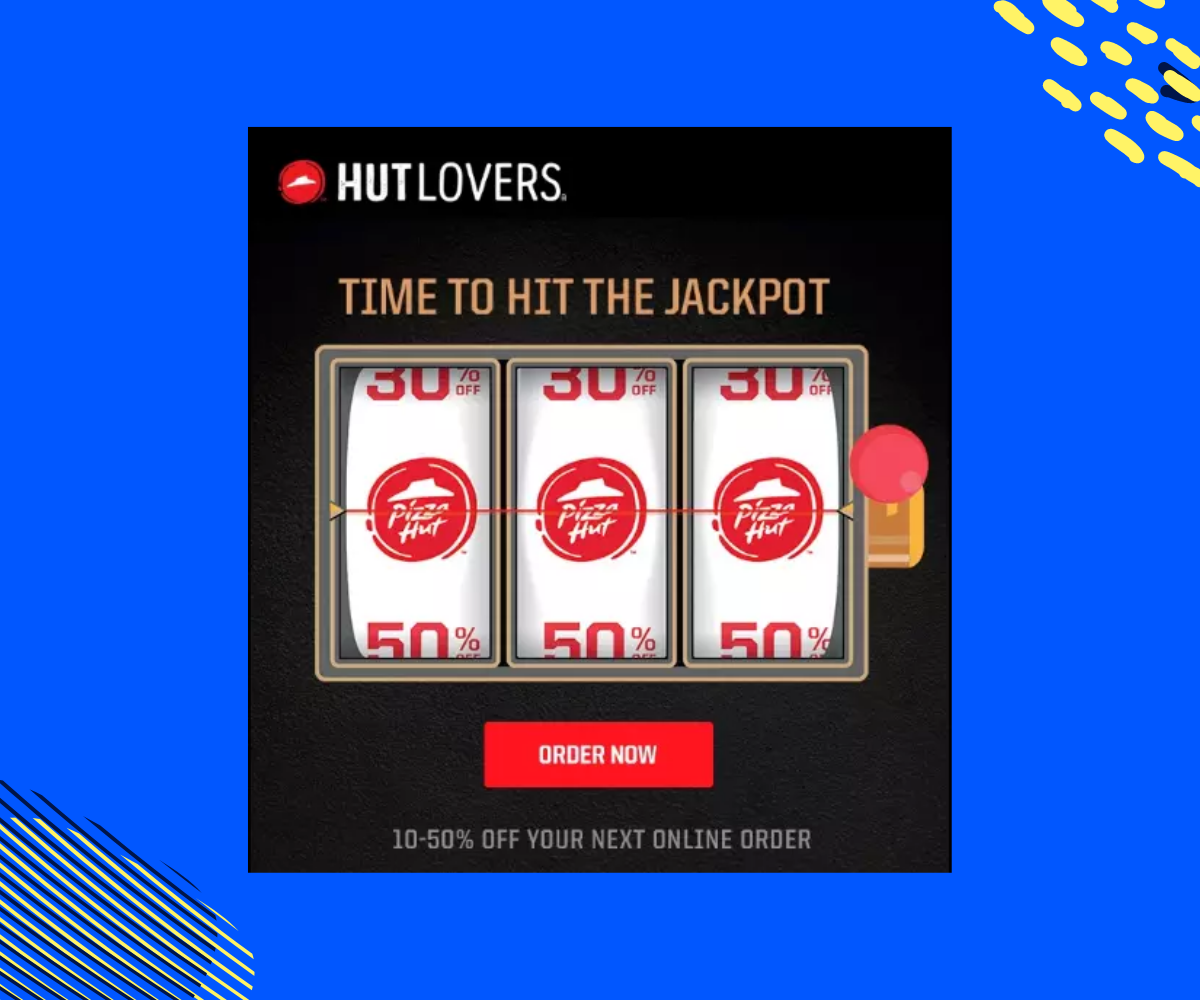
Send reactivation emails
Make a final effort to re-engage your inactive subscribers by dispatching reactivation emails. Incorporate alluring and irresistible offers while also reminding the recipient of the initial reasons for their subscription.
Consider the case of Sephora, a skincare company, which provides a compelling example. Sephora extends a 15% reward card to all unsubscribed customers in a bid to entice them back into the fold.
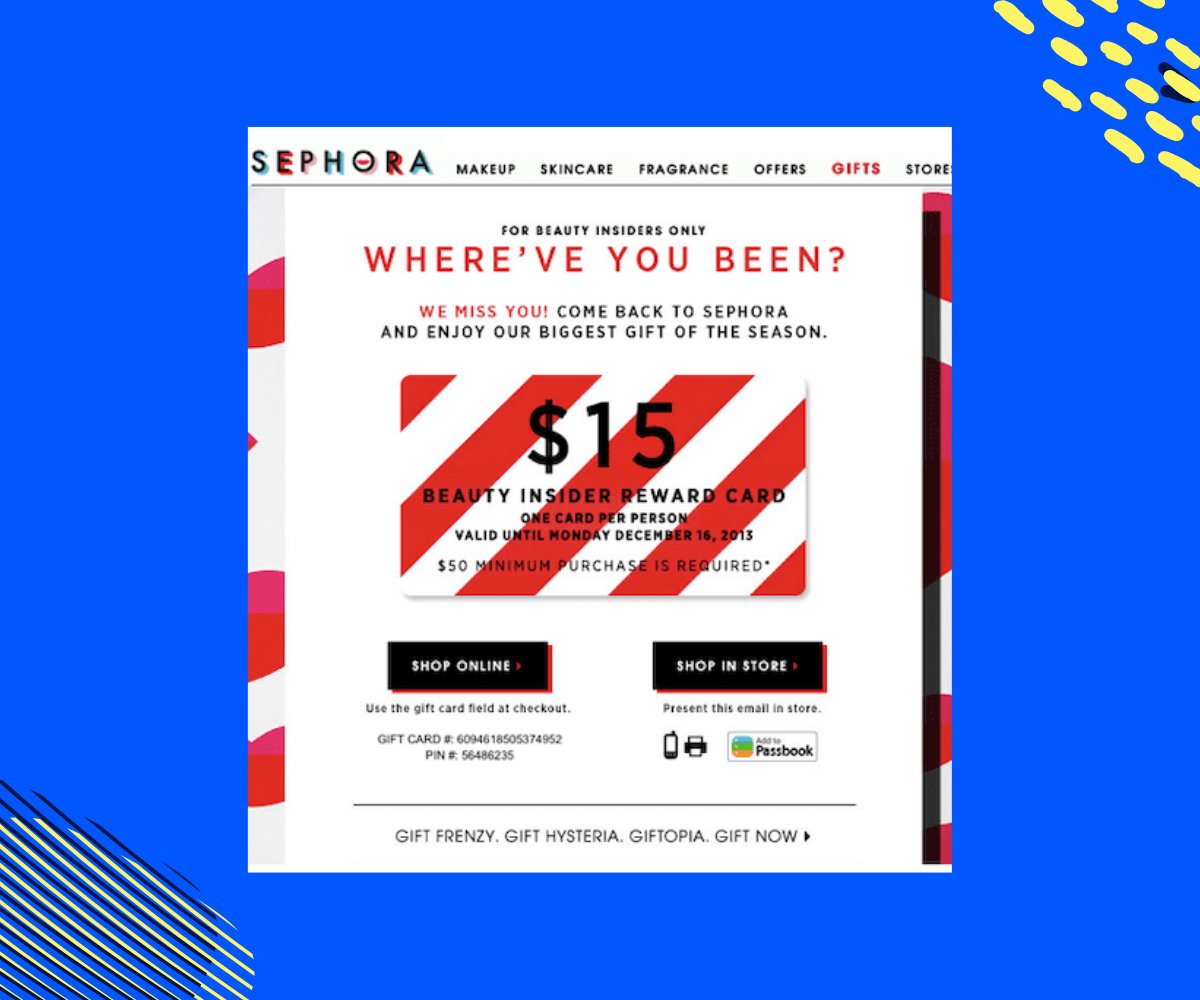
Ask for feedback
If all else fails and your recipients decide to unsubscribe from your mailing list despite your best efforts, seek their input regarding the reasons behind their decision. This feedback can serve as valuable insight for refining your strategy.
Consider implementing an automated email system that triggers whenever a subscriber opts out of your email list, inviting them to share their feedback.

